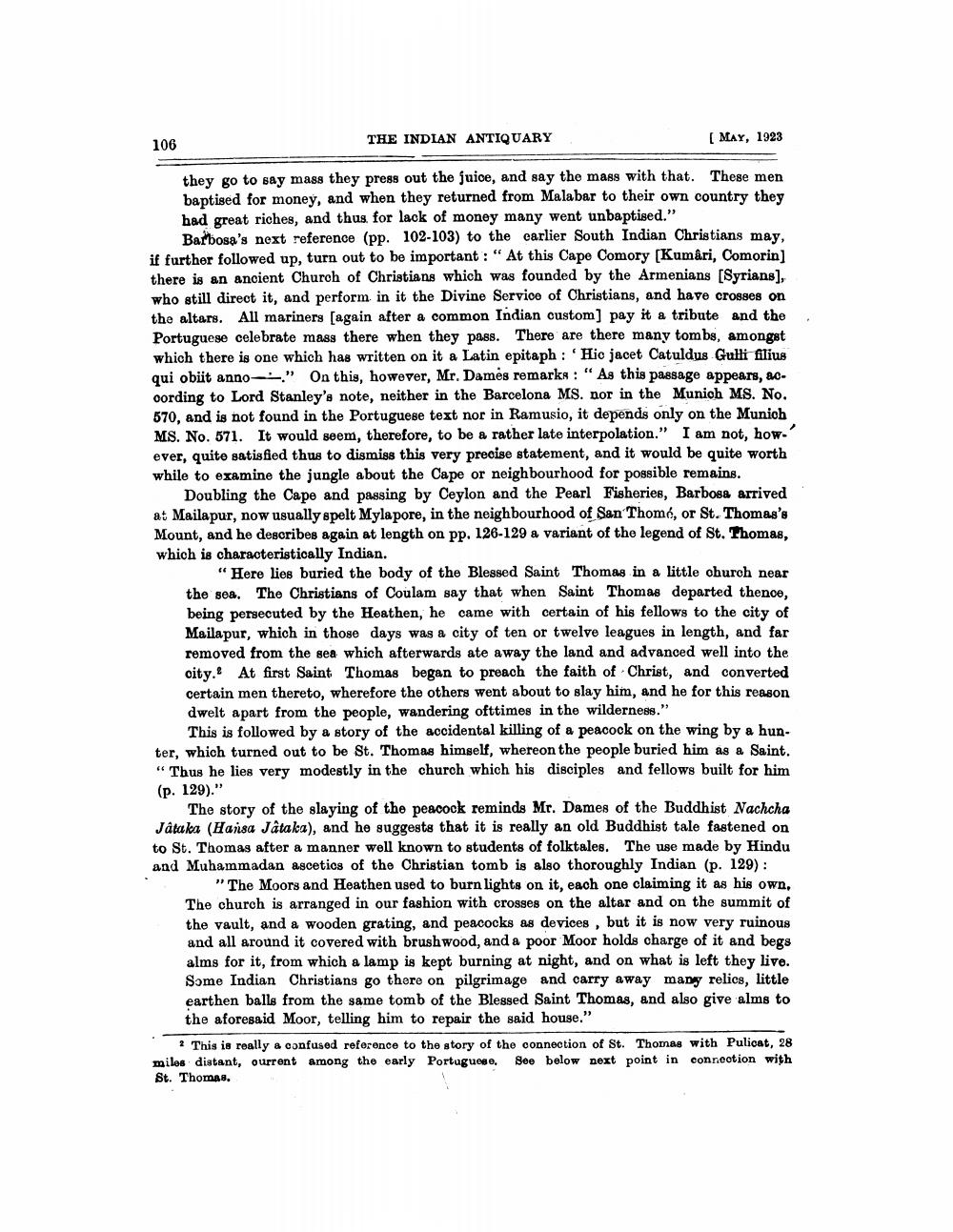________________
106
THE INDIAN ANTIQUARY
[ MAY, 1923
they go to say mass they press out the juice, and say the mass with that. These men. baptised for money, and when they returned from Malabar to their own country they had great riches, and thus for lack of money many went unbaptised."
Barbosa's next reference (pp. 102-103) to the earlier South Indian Christians may, if further followed up, turn out to be important: " At this Cape Comory [Kumâri, Comorin] there is an ancient Church of Christians which was founded by the Armenians [Syrians], who still direct it, and perform in it the Divine Service of Christians, and have crosses on the altars. All mariners [again after a common Indian custom] pay it a tribute and the Portuguese celebrate mass there when they pass. There are there many tombs, amongst which there is one which has written on it a Latin epitaph: 'Hic jacet Catuldus Gulli filius qui obiit anno." On this, however, Mr. Dames remarks: "As this passage appears, according to Lord Stanley's note, neither in the Barcelona MS. nor in the Munich MS. No. 570, and is not found in the Portuguese text nor in Ramusio, it depends only on the Munich MS. No. 571. It would seem, therefore, to be a rather late interpolation." I am not, however, quite satisfied thus to dismiss this very precise statement, and it would be quite worth while to examine the jungle about the Cape or neighbourhood for possible remains.
Doubling the Cape and passing by Ceylon and the Pearl Fisheries, Barbosa arrived at Mailapur, now usually spelt Mylapore, in the neighbourhood of San Thomé, or St. Thomas's Mount, and he describes again at length on pp. 126-129 a variant of the legend of St. Thomas, which is characteristically Indian.
"Here lies buried the body of the Blessed Saint Thomas in a little church near the sea. The Christians of Coulam say that when Saint Thomas departed thence, being persecuted by the Heathen, he came with certain of his fellows to the city of Mailapur, which in those days was a city of ten or twelve leagues in length, and far removed from the sea which afterwards ate away the land and advanced well into the city. At first Saint Thomas began to preach the faith of Christ, and converted certain men thereto, wherefore the others went about to slay him, and he for this reason dwelt apart from the people, wandering ofttimes in the wilderness."
This is followed by a story of the accidental killing of a peacock on the wing by a hunter, which turned out to be St. Thomas himself, whereon the people buried him as a Saint. "Thus he lies very modestly in the church which his disciples and fellows built for him (p. 129)."
The story of the slaying of the peacock reminds Mr. Dames of the Buddhist Nachcha Jataka (Hansa Jataka), and he suggests that it is really an old Buddhist tale fastened on to St. Thomas after a manner well known to students of folktales. The use made by Hindu and Muhammadan ascetics of the Christian tomb is also thoroughly Indian (p. 129):
"The Moors and Heathen used to burn lights on it, each one claiming it as his own, The church is arranged in our fashion with crosses on the altar and on the summit of the vault, and a wooden grating, and peacocks as devices, but it is now very ruinous and all around it covered with brushwood, and a poor Moor holds charge of it and begs alms for it, from which a lamp is kept burning at night, and on what is left they live. Some Indian Christians go there on pilgrimage and carry away many relics, little earthen balls from the same tomb of the Blessed Saint Thomas, and also give alms to the aforesaid Moor, telling him to repair the said house."
2 This is really a confused reference to the story of the connection of St. Thomas with Pulicat, 28 miles distant, ourrent among the early Portuguese. See below next point in connection with St. Thomas.




